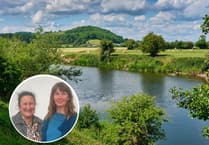LES Ruck is digging becoming the oldest miner in the Forest after being made a ‘Freeminer’ at the ripe old age of 92.
The former collier, who last worked in a mine 52 years ago, was sponsored by 80-year-old Forest poet and former workmate Dave Harvey.
But Les, from Ruardean, joked that he won’t be taking up Dave’s offer to open a new mine called ‘The Old Codgers’.
“I’m very happy to be made a Freeminer after all these years, it’s part of history, but I’m too old to start digging now,” he smiled.
“I’ve still got my miner’s helmet, lamps and knee pads and am doing alright for 92, but I don’t think it would be wise with two knee replacements and a hip replacement.”
And Les confessed that despite the “tremendous camaraderie” of mining when he worked at Cannop Colliery and Northern United Mine in Cinderford, it was a dangerous way of life.
“I got buried by a dirt fall in 1962. I was in the wrong place at the wrong time, but they could see the glow of my lamp through the muck and luckily got me out after about half an hour,”
he recalled.
To be declared a Freeminer - a tradition that dates back centuries - a person must be born and living “within the Hundred of St Briavels”, be over the age of 21 years and must have worked for a year and a day in a mine within the Hundred.
Once registered, Freeminers can stake their claim to set up their own mine or quarry in the Forest, known as a gale, and start digging for coal, iron ore, stone and other minerals.
Les is the 4,369th Freeminer since registers were first kept, exactly 180 years ago this month.
“It’s something I should have done 50 years ago, when I worked down the pit,” said Les. “I had the papers all signed by the NUM secretary, but when they closed Northern Mine at Christmas, 1965, and I went on to work for Rank Xerok for 17 years, I just forgot about it to be honest.
“Then when Dave mentioned ‘why don’t you become a Freeminer?’ I thought, ‘well, it’s a bit of history and it would be really nice.’ I suppose now I can be called ‘the oldest miner in the Forest’.
Les, who has more recently helped old colliers make compensation claims, comes from a long family tradition of miners, starting out at Cannop Colliery at the age of 15 in 1941, where he looked after the pit horses.
“Mining’s in my blood, even though I haven’t been underground for over 50 years. My great-grandfather, grandfather Thomas and dad Albert were all miners, so even after all this time, it’s great to keep that connection alive by becoming a Freeminer.
“Although it’s dirty work, the comradeship underground was second to none. When you go down for your shift, you’re down there for a long time.
“You don’t come up for lunch, you’re bound together down there, everyone looking out for everyone else. I’d have worked in the pit all my life if I could, despite the dirt, grime and hard work.” recalled Les Ruck.
“I started in the war, when boys took over a lot of work from full grown men… but we never got the full pay,” he laughed.
“I think I was on about 30 shillings (£1.50) a week to begin with. Then I went to Northern Colliery and worked my way up, getting my deputy’s papers in 1954, where I was in charge of about 20 miners at the coalface.
“Later I became an overminer, in charge of a ‘district’, and on the last shift on Christmas Eve, 1965, it was my job to make sure everyone was safely out. I was the last official down the shaft.
“I stayed on for a few weeks into 1966 doing salvage work, but that was the end of deep pit mining in the Forest.”
Les says he knows where there’s coal in the Forest, but it’s about 100 yards underground and would “take some digging”.
“I’m not about to start on that now, but it’s great to keep such a great part of the Forest’s history alive for a bit longer by becoming a Freeminer,” he added. “It’s a unique honour.
“As most babies are now born outside the ‘Hundred’, there aren’t many candidates left to be Freeminers, and it will probably die out completely one day.
“But when Dave (Harvey) suggested it, I was happy for him to apply. I was his boss when he first started, and as Dave reminds me, I could see after a short time he was a good miner and let him go and work at the coalface, where the money was better.
“And we’re still mates after all these years.”
Dave, who went on to work as a freeminer with his father after leaving Northern Colliery, said Les is still interested in mining and the local pits, and is highly knowledgeable about it
“I started as a trainee under Les in 1958 and worked on the coalface with him. I’ve known him ever since and go up and visit him every day - he’s got a fantastic memory of the mines and he’s a lovely man who’s got a good word for everyone.
“Eric Morris, the former president of the Freeminers, was going to get Les made up five years ago, but then he passed away, so I mentioned to Les recently let’s get it done, and got in touch with Deputy Gaveller Dan Howells who keeps the official register.
“The right to be a Freeminer is unique around the world, as far as I know, so Les is delighted to finally claim his rightful place in the historical tradition,” added Dave, who was the model for the Freeminer statue in Cinderford town centre.
“We’d be a good team. If we started digging, I think ‘Old Codgers Mine’ would be a great name.”
Deputy Gaveller Dan Howells said: “It is always a pleasure to register a new Freeminer, of which Les is only the second since I took office in 2011. Les is the 4,369th Freeminer to be registered since the passing of the Dean Forest (Mines) Act, with James Frowan being named as Freeminer Number 1 on September 1, 1838.
But although Les is unlikely to open a gale, the Forestry Commission England officer added after the ceremony: “Les showed much interest in the aluminium snow shovels that were near the back door to Bank House and was sure to count them on the way out.”
And Dan added that the Future for Freemining project is currently looking to give the unique tradition a new lease of life.
The need to involve new people, raising awareness and interest in the opportunity to become a Freeminer and to ensure appropriate training, are being provided as one of the 38 Foresters’ Forest Heritage lottery funded programmes.
See www.forestersforest.uk for more details.




